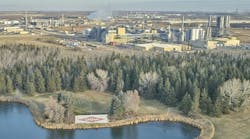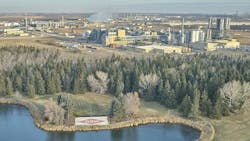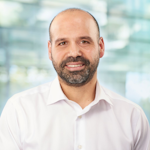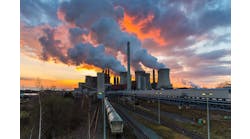Decarbonization and digitalization are converging at Dow’s $6.7 billion ethylene cracker expansion project in Fort Saskatchewan, Alberta, Canada.
Billy Bardin, Dow’s global climate transition director, discussed details of the project during the annual ARC Advisory Group Forum in Orlando on Feb. 7. The project, part of the company’s Path2Zero initiative to reach carbon neutrality by 2050, was finalized in November and will decarbonize approximately 20% of Dow’s global ethylene capacity.
Two days later, Dow announced it sold $1.25 billion in notes, $600 million at a rate of 5.15% due in 2034 and $650 million at a principal amount of 5.6% due in 2054. The green bond offering will help fund the Fort Saskatchewan upgrades, Dow said in a news release.
The project is a massive undertaking. When complete, the facility will produce and supply approximately 3.2 million metric tons of polyethylene and ethylene.
The construction involves creating a hydrogen-powered ethylene cracker, expanding polyethylene production, and implementing power and steam cogeneration. It also includes the establishment of off-site carbon sequestration, infrastructure upgrades and new control centers with offices, storage and maintenance facilities.
Embedded throughout the entire design plan is a significant emphasis on digitalization, according to Bardin.
“When we look at the facility, we’re trying to understand how we digitize the facility from the start, so that we can get to this track and trace of emissions and being able to audit and verify and assure that those emissions are tallied correctly,” Bardin said.
Dow has implemented a governance structure within the company that includes a climate steering team directly accountable to the CEO. This team oversees program management offices tasked with executing the company's climate transition initiatives, Bardin says.
To deliver on its climate goals, Dow is developing individuals who have expertise in both data science and architecture along with an environmental background, Bardin says.
Sitting alongside Bardin during the ARC sustainability session was Nathalie Marcotte, senior vice president and president of process automation for Schneider Electric. Marcotte talked about the importance of coupling sustainability efforts with digitalization. Schneider Electric’s digital transformation team works closely with the company’s sustainability organization to help Schneider Electric’s clients meet their climate goals, Marcotte says.
This alignment makes sustainability data more available across the organization, so everyone feels like they’re a part of the journey, Marcotte said.
Creating an Emissions 'System of Record'
Part of the carbon-tracking challenge, says Bardin, is identifying emissions monitoring systems that can integrate between the process control system and the ERP.
“We want to find unified tools that will allow us to have easier global visibility than we have today,” he told Chemical Processing following the panel discussion. “We have global visibility today, but there’s still a lot of manual intervention, so we’re looking for capabilities that integrate across the stack.”
Bardin said many startups and consulting firms are now offering carbon-tracking solutions. Dow is working with several partners to find solutions that are long term and viable.
“We want to find unified tools that will allow us to have easier global visibility than we have today. “We have global visibility today, but there’s still a lot of manual intervention, so we’re looking for capabilities that integrate across the stack.” -- Billy Bardin, Dow’s global climate transition director
“We need those systems to have the ability to easily import and export data cross platforms, so we’re not tied to a single vendor for a complete stack because I don’t think we will have a single vendor who will provide us with the level of expertise and capability from ERP all the way down to Level 0 at the control room, so those systems need to have the ability to talk to one or two others in an easier way so we can get that data to a cloud environment where we can manipulate, and track it.”
Bardin emphasized several key components for successfully delivering digital sustainability data across the enterprise. It begins at the operations level with the elimination of manual data entry, perhaps using a tablet to record control-system information, such as mass and energy balance calculations, and then sending that data through the manufacturing execution layer to ERP system.
“As we look at our digital program, there's a couple components,” Bardin says. “One is assuring that the data is actively reported at the field level, at the front line in the control room. And that data flows all the way from the control rooms to the board room. So that means single-entry data.”
The architecture must also be designed so the organization can easily pull data from different systems, audit it and validate any changes to the information.
“Otherwise, you never get to a system of record that can be used for auditing and assurance of carbon reductions,” Bardin says.
Empowerment Through Change
Change management plays a significant role in achieving the company's sustainability objectives. That’s because operations teams must adapt to rising expectations, ensuring the delivery of high-quality process data on CO2 reductions suitable for financial-level auditing.
“When you’re talking about accounting for CO2 reductions, that may come as part of an SEC reporting rule,” Bardin explains. “That’s a significant lift.”
The U.S. Securities and Exchange Commission plans to have a final ruling in place on climate-related disclosures for scope 1, 2 and 3 emissions by April, said Bank of America industrial analyst Andrew Obin during the same ARC Forum session in which Bardin and Marcotte participated.
“I think one of the most important things we did at Dow is that we worked on energy-efficiency programs for decades,” he adds, referring to the company’s Path2Zero roadmap of all its large carbon-emitting assets.
To enable that level of granular data, the company will need to connect older process control systems, some 50 to 60 years old, and integrate those with a new integrated data hub that leverages cloud connectivity to continuously monitor emissions reductions, Bardin says.
Marcotte says Schneider Electric works closely with its industrial customers to help them understand how digitalization will enhance their roles, helping them see the significant impact of their efforts, while making their jobs easier.
“Their job is not going away,” she says. “It’s going to be more interesting for them … It’s an evolution of their role.”




